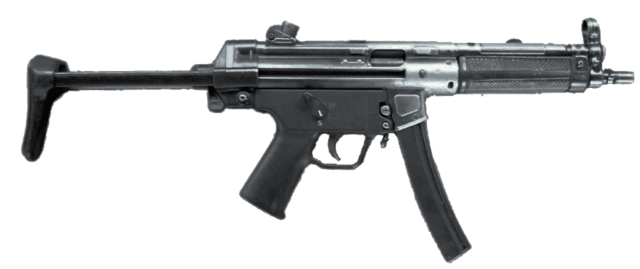
Introduction: A Submachine Gun Icon
The Heckler & Koch MP5 (Maschinenpistole 5) is one of the most renowned 9x19mm Parabellum submachine guns in history. Developed in the 1960s by the German firearms manufacturer Heckler & Koch (H&K), the MP5 has seen extensive use worldwide in law enforcement, military, and special operations units. Its reputation for reliability, precision, and durability has made it the benchmark for submachine guns for over 50 years.
This in-depth guide will explore the it's history, development, performance, variants, real-world use, and comparisons to other firearms, ensuring a complete and authoritative look at this legendary firearm.
Development and History
Origins: The Influence of the G3 and CETME
The MP5's origins can be traced back to the post-WWII period when German engineers, originally working for Mauser, relocated to Spain and helped develop the CETME rifle. Their work later influenced the design of the G3 battle rifle, which was adopted by the German Bundeswehr in 1959.
In the early 1960s, Heckler & Koch sought to create a compact, highly accurate submachine gun using the same roller-delayed blowback system found in the G3. By 1966, this project resulted in the MP5, initially designated as the HK54.
Adoption and Early Success
Upon its introduction, it was quickly adopted by elite military and law enforcement agencies worldwide. The German Federal Police (Bundespolizei) and West German counterterrorism unit GSG-9 were among the first to recognize its superior accuracy and control over competing submachine guns.
The 1980 Iranian Embassy Siege in London, carried out by British SAS operators, was a defining moment for the gun. The SAS used MP5A3 models to neutralize terrorists and rescue hostages in front of live global television audiences, cementing its reputation as the ultimate counterterrorism weapon.
Technical Overview: Operating System & Construction
Roller-Delayed Blowback System
The unique roller-delayed blowback action is what sets it apart from other 9mm submachine guns. Unlike direct blowback systems found in competitors like the Uzi or MAC-10, the bolt assembly features locking rollers that slow down the bolt's movement, ensuring:
- Reduced recoil
- Greater accuracy
- Higher reliability in sustained fire
Build Quality and Ergonomics
Manufactured with high-grade stamped steel receivers and polymer furniture, the MP5 exhibits exceptional craftsmanship. It features:
- A diopter drum sight system, allowing for superior target acquisition.
- A paddle magazine release, making reloads faster compared to push-button systems.
- An ambidextrous fire selector, configurable for semi-auto, burst, and full-auto fire (depending on model).
Variants and Modern Adaptations
The family has expanded over the decades, with specialized variants designed for specific tactical roles.
Major Variants:
| Model | Description |
|---|---|
| MP5A2 | Fixed stock version for military/law enforcement. |
| MP5A3 | Retractable stock for greater portability. |
| MP5K | Compact “Kurtz” variant with a shortened barrel, ideal for concealed carry. |
| MP5SD | Integrally suppressed version, optimized for stealth operations. |
| MP5/10 & MP5/40 | Chambered in 10mm Auto and .40 S&W, providing greater stopping power. |
| MP5N | U.S. Navy variant with maritime corrosion resistance. |
The MP5SD remains a favorite for special forces conducting suppressed operations, while the MP5K is often chosen for VIP protection teams due to its discreet size.
Performance and Ballistics: What Makes it Exceptional?
Accuracy and Range
Despite being a submachine gun, the gun is exceptionally accurate. Its effective range is 50-100 meters, with maximum engagements possible up to 200 meters.
Cyclic Rate and Recoil Control
The gun has a cyclic rate of fire of 800 rounds per minute, striking a balance between controlled bursts and full-auto stability. The roller-delayed system significantly reduces felt recoil, making it easy to keep on target during sustained fire.
Ammunition Compatibility
The gun is chambered in 9x19mm Parabellum, compatible with:
- Standard FMJ rounds (115gr, 124gr, 147gr)
- +P and +P+ duty rounds (hotter loads for greater stopping power)
- Subsonic ammo for suppressed MP5SD models
Global Use: Military, Law Enforcement, and Special Forces
The gun has been deployed by elite forces worldwide, including:
- British SAS – Used in the Iranian Embassy Siege (1980).
- German GSG-9 – Used to rescue Lufthansa Flight 181 hostages (1977).
- French GIGN – Deployed in counterterrorism operations.
- U.S. Navy SEALs – Previously issued but replaced by the HK416.
While still widely used, many agencies are transitioning to modern weapons like the MP7 and AR-based carbines.
MP5 vs. Modern Competitors: Is It Still Relevant?
While the MP5 is an outstanding submachine gun, modern alternatives offer advantages:
| Firearm | Pros | Cons |
|---|---|---|
| MP5 | Low recoil, precision, reliability | Limited armor penetration |
| H&K MP7 | 4.6x30mm AP rounds, ultra-compact | Expensive ammunition |
| B&T APC9 | Modular, lightweight | Higher price |
| CZ Scorpion EVO 3 | Affordable, ergonomic | More recoil |
Despite the rise of compact AR-style carbines and PDWs, it remains in service worldwide due to its legendary performance and reliability.
Conclusion: Legacy and Future
The H&K MP5 remains one of the most respected submachine guns ever made. Its roller-delayed blowback system, unmatched accuracy, and elite unit adoption have made it an enduring icon of firearms history.
While modern weapons have started to replace the gun, it remains relevant in specialized roles, ensuring its place in the hands of elite forces for years to come.
Key Takeaways:
✅ Unmatched accuracy for a submachine gun
✅ Low recoil and superior control
✅ Used by the world’s most elite forces
✅ Still in service despite newer designs
With its legendary performance, craftsmanship, and combat-proven reputation, the MP5 is a submachine gun that will never be forgotten.
Sources and References
? Heckler & Koch Official Website – www.hk-usa.com
? Ian McCollum, Forgotten Weapons – Technical Analysis on MP5
? Larry Vickers, Vickers Tactical – MP5 Field Reviews
Discussions on HK weapons can be found here:
If you know of any forums or sites that should be referenced on this listing, please let us know here.




